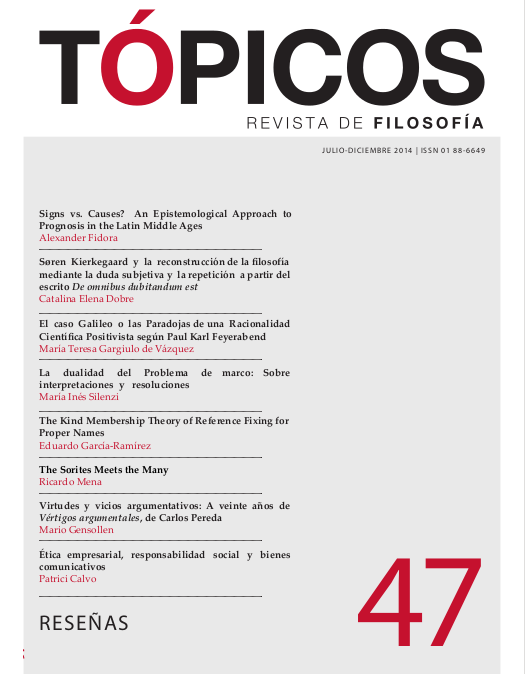Artículos
Publicado 2014-12-07
Palavras-chave
- dependencia causal,
- derivación y presuposición.
Como Citar
Ramírez, E. G. (2014). The Kind Membership Theory of Reference Fixing for Proper Names. Tópicos, Revista De Filosofía, 47, 113-138. https://doi.org/10.21555/top.v0i47.664
Resumo
Gareth Evans (1973; 1982) nos ofrece lo que parece ser un punto medio entre el descripcionismo y la teoría de la referencia directa sobre el mecanismo mediante el cual fijamos la referencia de los nombres propios. Ésta es la denominada “teoría de la fuente causal de la referencia”. En un artículo reciente Imogen Dickie (2011) presenta objeciones importantes a la teoría de Evans y concluye presentando una teoría alternativa, la denominada “teoría de la gobernabilidad”. En este trabajo quiero ofrecer una propuesta alternativa que evite la tesis de gobernabilidad de Dickie. Para ello mostraré, primero, cómo lidiar con las objeciones de Dickie sin alejarse demasiado de la propuesta original de Evans y, segundo, defenderé que la teoría resultante –la que llamo “teoría de la pertenencia a tipos”– es más simple y exitosa que la propuesta por Dickie.Referências
- Bach, K., 2006: “What Does it Take to Refer?,” in E. Lepore and B.C. Smith (eds.) 2006: The Oxford Handbook of Philosophy of Language, Oxford: Oxford University Press.
- Campbell, J., 2002: Reference and Consciousness, Oxford: Oxford University Press.
- Dickie, I., 2011: “How Proper Names Refer,” Proceedings of the Aristotelian Society, Vol. CXI, Part 1, 43-77.
- Dickie, I., 2014: “The Sortal Dependence of Demonstrative Reference,” European Journal of Philosophy, 22, 1, 34-60.
- Evans, G., 1973: “The Causal Theory of Names,” Aristotelean Society, Supl. Vol. 4, 187-208.
- Evans, G., 1982: The Varieties of Reference, J. McDowell, (ed.) Oxford: Oxford University Press.
- Frege, G., 1892: “On Sense and Nominatum,” in A.P., Martinich (ed.), 2002: The Philosophy of Language, Oxford: Oxford University Press.
- Jackson, F., 2010: Language, Names, and Information, Oxford: Blackwell.
- Lewis, D., 1973: “Causation,” Journal of Philosophy, 70, 556-67.
- Lewis, D., 1986: On the Plurality of Worlds, Oxford: Blackwell.
- Grice, P., 1975: “Logic and Conversation,” in P. Cole and J. Morgan (eds.) Syntax and Semantics, Vol. 3. New York: Academic Press, 41-58.
- Kaplan, D., 1989: “Demonstratives” in J., Almong, J., Perry, and H. Wettstein (eds.): Themes From Kaplan, Oxford: Oxford University Press. 481-563.
- Korta, K., and Perry, J., 2011. Critical Pragmatics. An Inquiry into Reference and Communication, Cambridge: Cambridge University Press.
- Kripke, S., 1977: “Speaker’s Reference and Semantic Reference,” in P. French, et. al., (eds.): Contemporary Perspectives in the Philosophy of Language, Minneapolis: University of Minnesota Press, 6-27.
- Kripke, S., 1981: Naming and Necessity, Cambridge, MA: Harvard University Press.
- Lewis, D., 1979: “Scorekeeping in a Language Game,” Journal of Philosophical Logic, 8, 339-59.
- Lewis, D., 1984: “Putnam’s Paradox,” Australasian Journal of Philosophy, 62, 3, 221-36.
- McGinn, C., 1981: “The mechanism of reference,” Synthese, 49, 157- 86.
- Montague, R., 1973: “On the proper treatment of quantification in ordinary English,” in J. Hintikka, et. al. (eds.) Approaches to Natural Language, Dordrecht: Reidel. 221-42.
- Putnam, H., 1975: “The meaning of meaning,” in H. Putnam, 1975: Mind, Language, and Reality. Philosophical Papers, Vol. 2. Cambridge: Cambridge University Press.
- Russell, B. 1905: “On Denoting,” Mind, XIV, 479-93.
- Salmon, N., 1981: Reference and Essence, Oxford: Blackwell.
- Salmon, N., 1986: Frege’s Puzzle, Cambridge, MA: MIT Press.
- Soames, S. 2002: Beyond Rigidity: The unfinished semantic agenda of Naming and Necessity, Oxford: Oxford University Press.
- Stalnaker, R., 1999: Context and Content, Oxford: Oxford University Press.
- Strawson, P., 1953: “On Referring,” Mind, LIX, 320-44.






